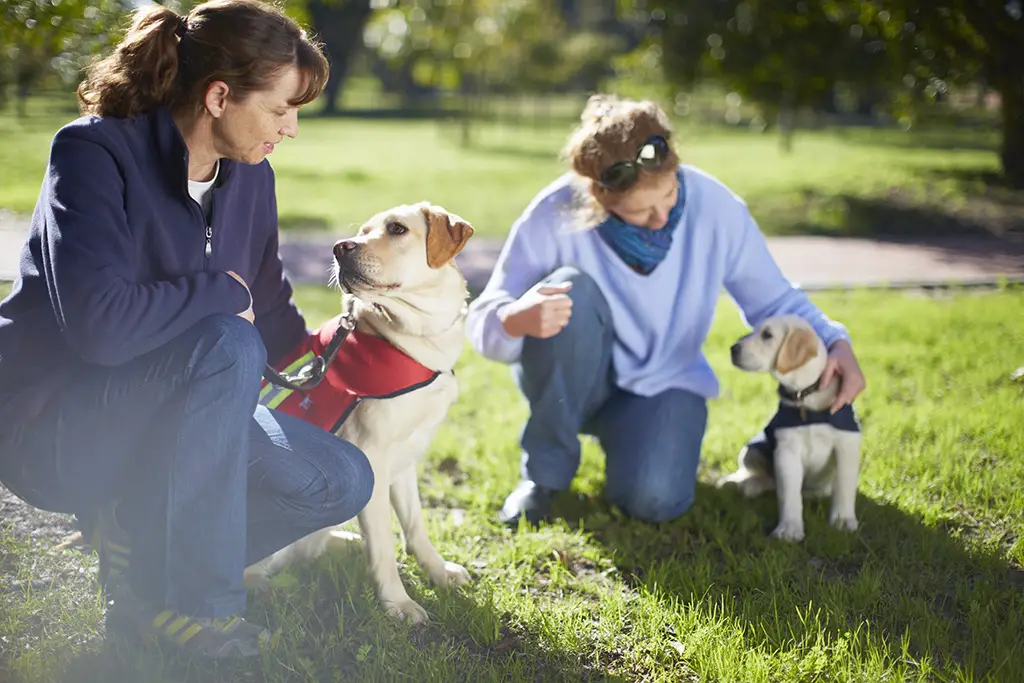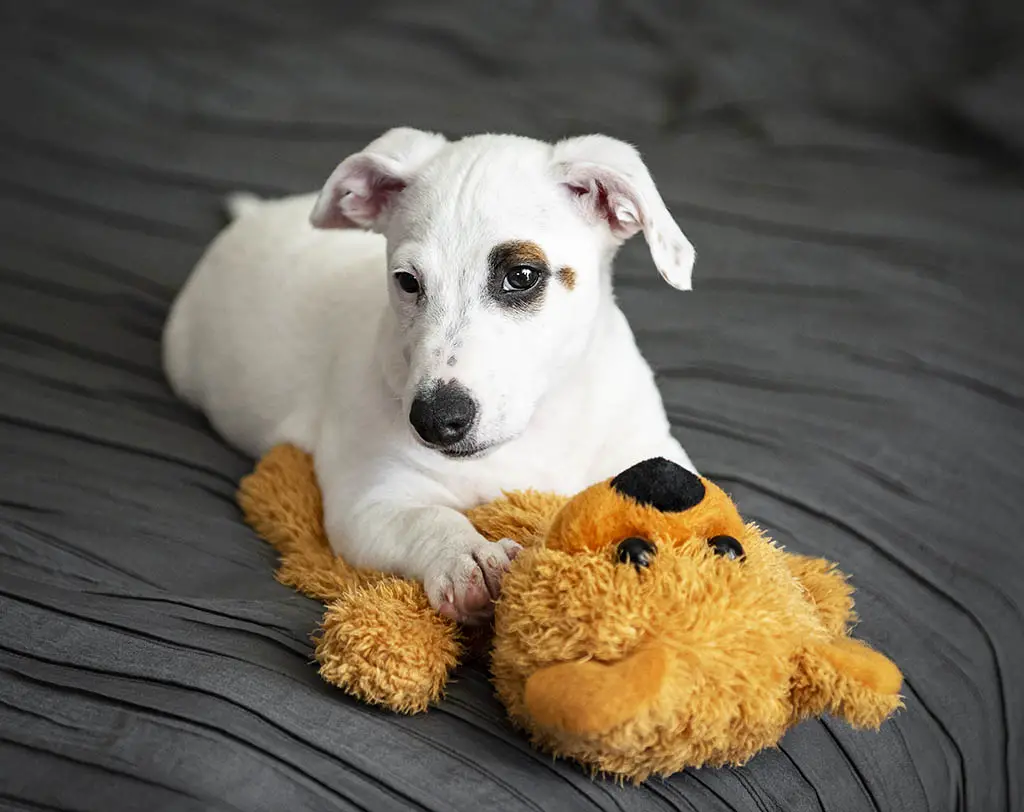Your dog might be the most adorable creature on Earth, but if they’re too shy/easily frightened, they may not make efficient therapy dogs. As a companion that offers psychological and physical support, a therapy dog needs to be well-trained. Unfortunately, professional dog training isn’t cheap, so not everyone can afford it. You can train your dog yourself and get excellent results. But what goes into therapy dog training? Well, keep reading to find out!
Article contents
How to train a therapy dog
If you don’t know what skills to focus on in your training regime, the Canine Good Citizen (CGC) test model should be a good start. The CGC is a program that tests a dog’s behavior and ability to do basic functions, like handling strangers, obeying simple commands, responding to calls, etc. So, how do you train your dog for that test?
1. Socializing with strangers
The ultimate goal of therapy dogs is to give people emotional and psychological support, offering comfort and affection. As you can guess, the dog has to be friendly, confident, and comfortable around humans. So, your priority is to help them be more sociable at an early age. All you have to do is expose your dog to the world as much as possible. That includes visiting numerous locations and meeting different people.
Here’s the thing: It’s crucial to establish a positive environment when you’re doing so. Offering a treat or a few praises after every interaction might help them associate sociability with food and fun. You don’t have to take them out of the pet store and travel the world immediately. Do it gradually. Start by getting them accustomed to a few family members, then have them meet a friend or two. Over time, you can take them to big gatherings or busy parks.
2. Obedience training
That includes training your dog to sit, stay, and lie down. Training dogs to answer these commands makes the experience more fun and builds communication between them and the handlers.
Laying down / sitting
Again, you want to use treats to make your dog more responsive. Hold the treat to their nose and lift it over their head to get them to sit. Put it down along the ground to prompt them to lie down. Once your dog gets in the coveted position, use a clicker to indicate they’ve done a good job. Over time, your dog should get used to sitting and lying down using a treat.
Now, repeat the cycle using the same hand gestures but without treats. If they do well, offer them a treat with your other hand. That instills the hand signals in their brain. Then add a verbal cue to the hand gestures like “down” or “sit” and continue to use the clicker. Eventually, your dog will respond to the verbal cues alone.
Staying
Training your dog to stay in place isn’t any different. Order them to sit or lie down. Then, give the verbal cue “stay,” wait half a second, use the clicker to mark that behavior, and offer them a treat. Use the word “free” to break the dog out of the still pose, then give them a treat. Repeat the cycle, gradually increasing the waiting time.
If the dog breaks the position before the time is up, go back to a shorter timespan and give them low-value treats. That ensures they enjoy moving freely as much as staying in position.

3. Handling exercises
One of the many ways therapy dogs help people is by reducing their stress levels and increasing the production of oxytocin (happy hormone) through petting. Unfortunately, some dogs can be sensitive to the touch, especially in areas like the paws and the belly. Handling exercises can help them get used to being petted, examined, and brushed by people.
Like with socializing, you want to do it gradually. Start by touching a non-sensitive area in the dog, like the back, then give them a treat and a few praises. Again, that helps view touching as a positive experience. Touch their back again for a longer time, then give them another treat. Now try squeezing or rubbing the same area for a few seconds, then another treat. When the dog becomes responsive enough, you can target the sensitive areas, like the muzzle, paws, or belly.
4. Loose leash walking exercises
Going on walks is a crucial part of the therapy dog experience, as it relieves stress, anxiety, and depression. That said, tightening the leash on your dog can make them anxious and scared, which defeats the purpose of walks. You want to keep a loose leash. Not only does it improve the dog’s mood, but it also makes them more responsive. It’s easier said than done, though, as they can be frightened by leashes.
So, how do you do it? Gradually. Start by putting the collar on their necks for a short time inside the house. As always, you want them to associate the leash with a positive experience. So, try playing with them or giving them treats after you put the leash on. Practice walking with your dog at home first. When you both get used to it, take them outside. The noise, smells, and sights might overwhelm them, so keep the first few walks short.
5. Interacting with other dogs
Training a dog to socialize with other dogs isn’t much different from training them to interact with humans. You have to do it gradually. Start by taking them to a place with other dogs while keeping them at a distance. Let them absorb the presence of these dogs and offer them treats just for being there. Then, gradually close that gap over however long they’re comfortable with, offering treats along the way. Eventually, they’ll get used to interacting with other dogs.
6. Responding to calls
The ability to respond to calls determines how fluid the relationship between a therapy dog and a handler will be. For your calls to be effective, make your dog think coming to you is rewarding and exciting. You can incentivize them with toys or treats. Stand at a small distance, then call your dog’s name and say “come” in a friendly tone. When they do, offer them the treat/toy and a few praises. Repeat this action while gradually increasing the distance every time. Eventually, they’ll respond to your calls without incentives.

7. Supervised separation
If a therapy dog gets depressed when you’re not around them, they won’t be able to do their job effectively. How can they boost others’ morale when they’re feeling down in the first place? A therapy dog must show confidence and assertiveness at all times. So, you want to train them to get used to being alone.
Start by giving your dog a stuffed toy and leaving the room for a short time. The toy should distract them from loneliness. When you come back, reward them with a treat. Repeat this action while increasing the timespan between leaving and returning each time. Then, take the toy away to help your dog face loneliness without distractions, and repeat the cycle.
Wrapping up
Now you understand how therapy dog training goes. Most exercises revolve around helping the dog adopt a positive, confident attitude to give people the emotional boost they need. It’s not easy, and there’s a lot to cover, but the results are worth it.
